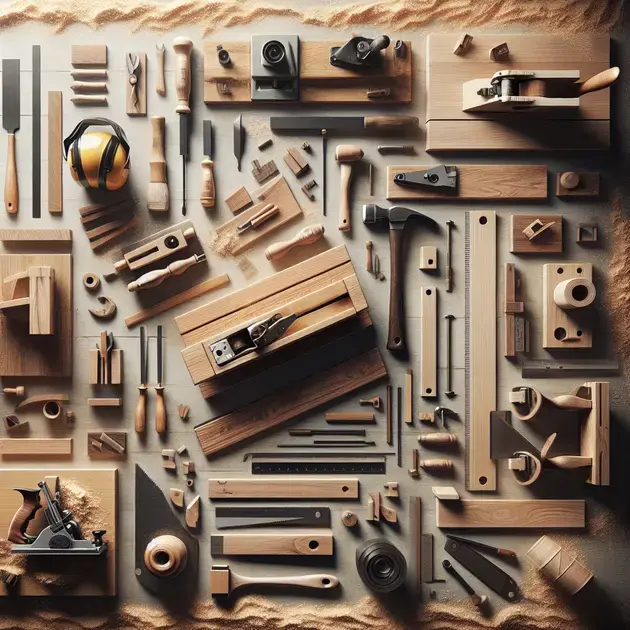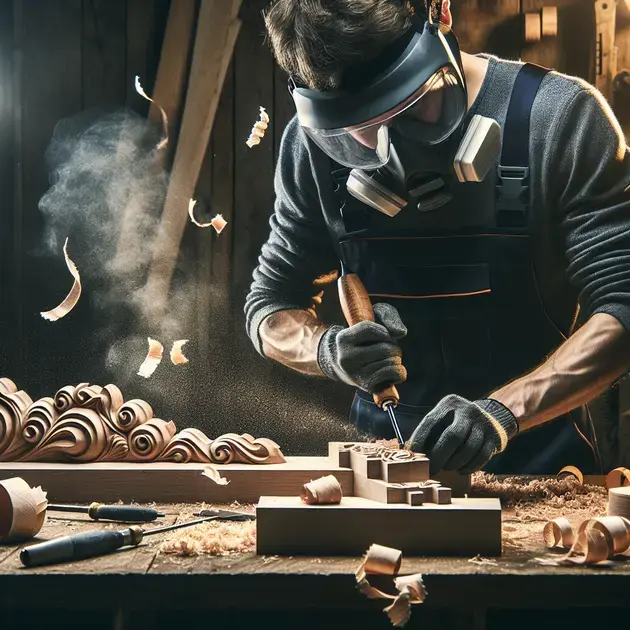Are you a beginner in the world of woodworking? You’ve come to the right place! In this blog post, we will explore some amazing tips and tricks to help you get started with Wood Working Wonders. Whether you’re looking to create simple DIY projects or dive into more complex wood crafting, we’ve got you covered.
Woodworking has gained significant popularity in recent years, with more and more people discovering the satisfaction of creating beautiful pieces with their own hands. From choosing the right type of wood to mastering essential techniques, this post will equip you with the knowledge you need to embark on your woodworking journey with confidence.

Woodworking Hazards to Avoid
Woodworking can be a rewarding hobby, but it also comes with its fair share of hazards. To ensure your safety in the workshop, it is important to be aware of and avoid common woodworking hazards. One crucial aspect to pay attention to is the proper handling of power tools. Always wear appropriate safety gear, such as goggles and ear protection, and make sure to read and follow the manufacturer’s instructions for each tool. Additionally, be mindful of your surroundings and keep your workspace clean and organized to prevent accidents.
Another hazard to watch out for in woodworking is exposure to harmful chemicals. When working with stains, paints, or finishes, make sure to use them in a well-ventilated area to avoid inhaling toxic fumes. It is also important to wear a mask to protect yourself from dust and other airborne particles that can be harmful to your respiratory system. Properly disposing of any waste materials is also crucial to prevent environmental hazards.
One often overlooked hazard in woodworking is repetitive strain injuries. To avoid this, it is important to practice good ergonomics and take regular breaks to rest your muscles and joints. Stretching before and after woodworking sessions can also help prevent injuries. Investing in ergonomic tools and equipment can make a significant difference in reducing the risk of repetitive strain injuries.
Furthermore, fire hazards are a real concern in woodworking, especially when working with flammable materials such as wood stains and oils. Always have a fire extinguisher within reach in case of emergencies, and never leave any materials that can easily catch fire near heat sources. Following proper fire safety protocols is essential to prevent accidents in the workshop.
By being vigilant and proactive in identifying and avoiding woodworking hazards, you can enjoy your craft safely and confidently. Remember, safety should always be your top priority in any woodworking project.
Essential Tools Every Beginner Needs
As a beginner in woodworking, having the right tools can make a world of difference in the quality of your projects. One essential tool every beginner needs is a reliable circular saw. This versatile tool is great for making straight cuts and can be used for a variety of woodworking tasks. Look for a saw with adjustable blades and a comfortable grip for ease of use.
Another must-have tool for beginners is a quality set of chisels. Chisels are essential for carving, shaping, and detailing wood pieces. Invest in a set that includes a variety of sizes to cover different woodworking needs. Keeping your chisels sharp and well-maintained is key to achieving precise and clean cuts.
A good quality hammer is also an essential tool for any woodworking beginner. Choose a hammer that feels comfortable in your hand and has a good balance for accurate striking. Whether you are driving nails or assembling joints, a reliable hammer is indispensable in any woodworking project.
Additionally, a combination square is a versatile tool that every beginner woodworker should have in their toolbox. This tool is used for measuring and marking accurate angles, depths, and lengths in woodworking. Look for a combination square with a durable steel blade and easy-to-read markings for precise measurements.
Lastly, a sturdy workbench is essential for any woodworking beginner to have a stable and secure workspace. Invest in a workbench that is of proper height, sturdy construction, and has ample workspace for your projects. A well-built workbench will provide you with the stability and support needed for various woodworking tasks.
Mastering Basic Woodworking Techniques
Mastering basic woodworking techniques is essential for any woodworker looking to improve their skills and tackle more advanced projects. One fundamental technique to master is proper measuring and marking. Invest in a quality tape measure, ruler, and marking tool to ensure accurate and precise measurements in your woodworking projects.
Learning how to make different types of joints is another crucial woodworking technique to master. Practice making basic joints such as butt joints, miter joints, and dovetail joints to understand how they work and when to use them in your projects. There are various online resources and tutorials available on websites like Woodworkers Guild of America that can help you learn and practice different joint techniques.
Sanding is a basic woodworking technique that can greatly improve the finish and quality of your projects. Invest in a quality random orbital sander and sandpaper of different grits to achieve smooth and polished surfaces. Proper sanding techniques, such as sanding with the grain and progressively using finer grits, can make a significant difference in the final look of your woodworking projects.
Understanding how to properly apply wood finishes is also an important woodworking technique to master. Whether you are staining, painting, or applying a clear finish, knowing the right techniques and tools to use can enhance the overall appearance and durability of your projects. Websites like Popular Woodworking offer step-by-step guides on applying different types of finishes for a professional-looking result.
Finally, practicing proper safety protocols and using safety equipment is a fundamental woodworking technique that every woodworker should master. Always wear appropriate safety gear, such as goggles, ear protection, and a dust mask, to protect yourself from potential hazards. Familiarize yourself with workshop safety guidelines and always prioritize safety in all your woodworking endeavors.

Must-Have Safety Gear for Beginners
When starting out in woodworking, it is essential to prioritize safety above all else. Investing in the right safety gear can make a significant difference in the outcome of your projects and your overall well-being. Here are some must-have safety gear items for beginners:
1. Safety Glasses
Protecting your eyes should be a top priority when working with wood. Safety glasses can prevent dust, sawdust, and wood chips from getting into your eyes and causing injury. Look for a comfortable pair that fits securely and provides adequate coverage.
2. Hearing Protection
The loud noise produced by power tools and machinery in the workshop can damage your hearing over time. Invest in a pair of ear muffs or ear plugs to protect your ears from the noise. This gear is essential for maintaining long-term hearing health.
3. Respirator Mask
Woodworking often involves working with materials that produce fine dust particles. A respirator mask can help filter out these particles and protect your lungs from harmful substances. Choose a mask that is comfortable to wear for extended periods.
4. Work Gloves
Protecting your hands from splinters, cuts, and abrasions is crucial in woodworking. Invest in a pair of work gloves that provide a good grip and dexterity while keeping your hands safe from potential injuries. Look for gloves that are suited for woodworking tasks.
5. First Aid Kit
Accidents can happen in the workshop, so it’s important to have a well-equipped first aid kit on hand. In case of minor cuts, scrapes, or burns, having the necessary supplies readily available can help you address injuries promptly and effectively.
Creating Stunning Woodworking Projects
Embarking on woodworking projects opens up a world of creativity and craftsmanship. To create stunning woodworking projects that showcase your skills and passion, here are some essential tips to keep in mind:
1. Choose High-Quality Materials
The quality of your woodworking project is heavily influenced by the materials you use. Opt for premium wood types that not only look visually appealing but also offer durability and strength to your creations. Consider experimenting with exotic woods for a unique touch.
2. Plan Your Design Carefully
Before diving into a woodworking project, take the time to plan out your design meticulously. Consider the dimensions, proportions, and details of the project to ensure a cohesive and aesthetically pleasing outcome. A well-thought-out design is key to creating stunning woodworking projects.
3. Master Finishing Techniques
The finish of a woodworking project can elevate its overall appearance and protect the wood from wear and tear. Experiment with different finishing techniques such as staining, varnishing, or lacquering to achieve the desired look for your project. A flawless finish can make all the difference.
4. Pay Attention to Detail
Great woodworking projects are often distinguished by their attention to detail. Focus on craftsmanship and precision in every cut, joint, and finish. Small details like chamfered edges, decorative accents, or inlay work can take your project from good to extraordinary.
5. Embrace Creativity
While following woodworking plans and techniques is important, don’t be afraid to infuse your projects with your unique style and creativity. Embrace experimentation, try new ideas, and let your imagination guide you to create stunning woodworking projects that reflect your personality and passion for the craft.
Exploring Advanced Woodworking Skills
As you progress in your woodworking journey, exploring advanced skills can take your craftsmanship to the next level. Here are some advanced woodworking skills to consider mastering:
1. Joinery Techniques
Mastering advanced joinery techniques such as dovetail joints, mortise and tenon joints, and finger joints can greatly enhance the strength and aesthetics of your woodworking projects. Practice precision and accuracy to achieve seamless and durable connections in your creations.
2. Wood Carving
Wood carving is a traditional woodworking skill that adds intricate detailing and decorative elements to your projects. Experiment with carving tools and techniques to create beautiful designs, patterns, and textures in wood. Developing your wood carving skills can bring a unique dimension to your work.
3. Inlay and Marquetry
Inlay and marquetry involve incorporating decorative elements like wood veneers, metals, or shells into the surface of your woodworking projects. Mastering these techniques requires precision cutting, fitting, and gluing to create stunning visual effects and intricate patterns on your pieces.
4. Turning and Lathe Work
Woodturning on a lathe opens up a whole new world of woodworking possibilities. Learn how to shape and sculpt round objects like bowls, vases, and spindles using a lathe. Practice different cutting techniques and explore the versatility of turning to add dynamic elements to your projects.
5. Advanced Finishing Methods
Experimenting with advanced finishing methods like French polishing, hand-rubbed finishes, or elaborate surface treatments can elevate the appearance and feel of your woodworking projects. Mastering the art of finishing allows you to enhance the natural beauty of wood and create truly exceptional pieces.
Conclusion
When venturing into the world of woodworking, ensuring safety through the use of essential safety gear is paramount. Safety glasses, hearing protection, a respirator mask, work gloves, and a first aid kit are indispensable items for beginners to safeguard themselves from potential hazards.
Creating Stunning Woodworking Projects
Embarking on woodworking projects demands a meticulous approach. Opting for high-quality materials, careful design planning, mastering finishing techniques, paying attention to detail, and embracing creativity are key factors in producing woodworking projects that reflect skill, passion, and creativity.
Exploring Advanced Woodworking Skills
As woodworking skills progress, mastering advanced techniques such as joinery, wood carving, inlay and marquetry, turning and lathe work, and advanced finishing methods can elevate craftsmanship to new heights. These skills offer avenues for innovation, creativity, and the creation of truly exceptional woodworking pieces.